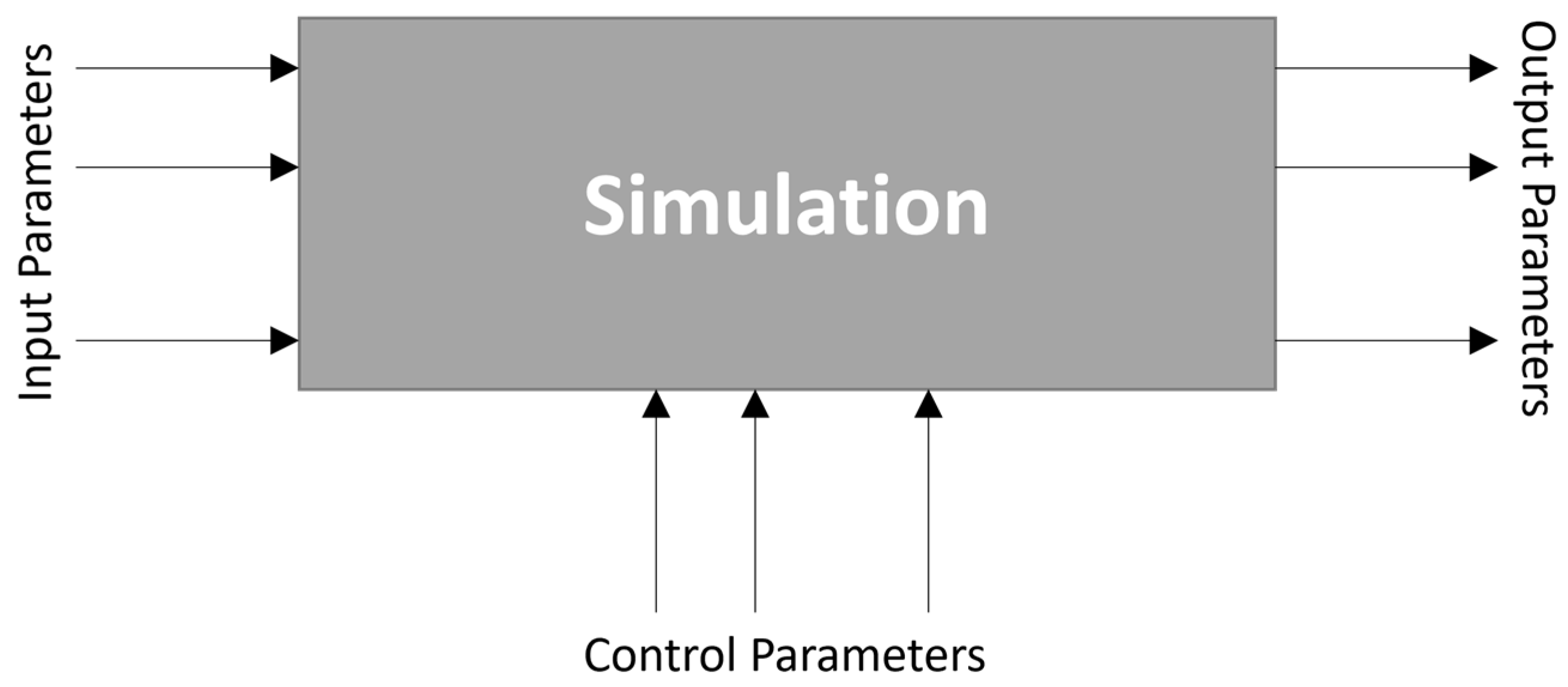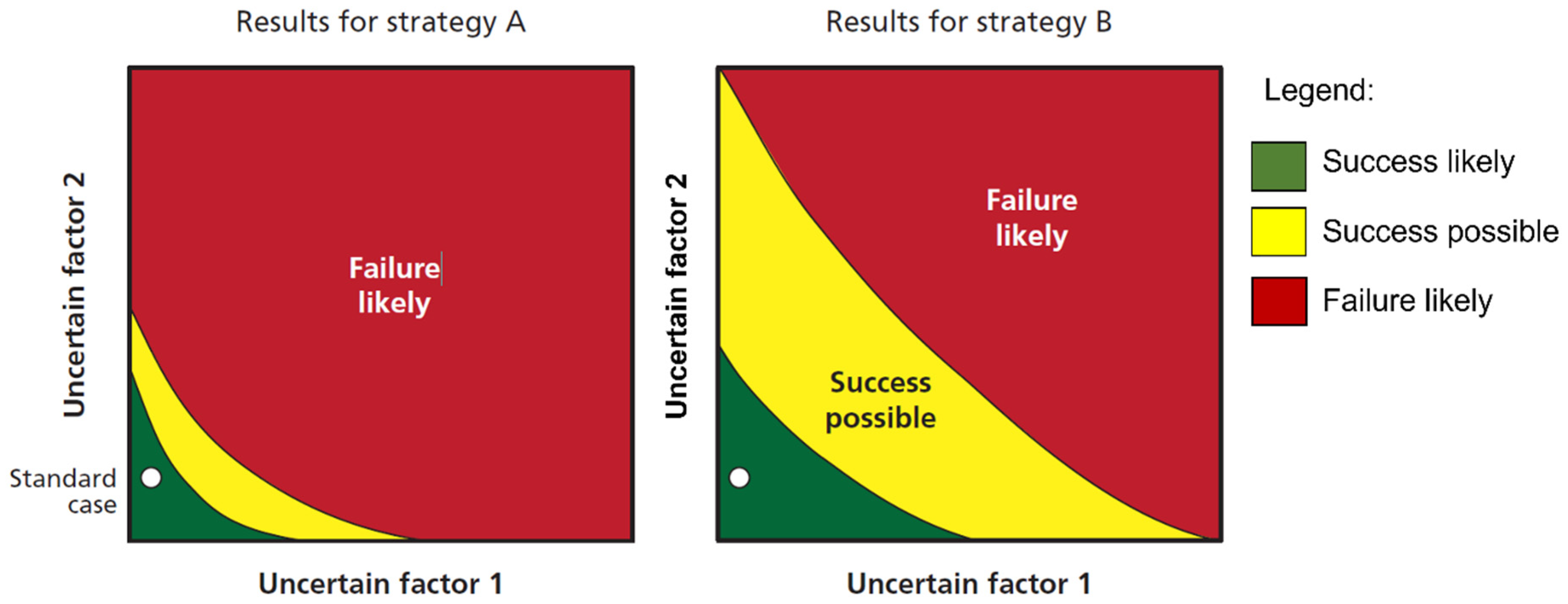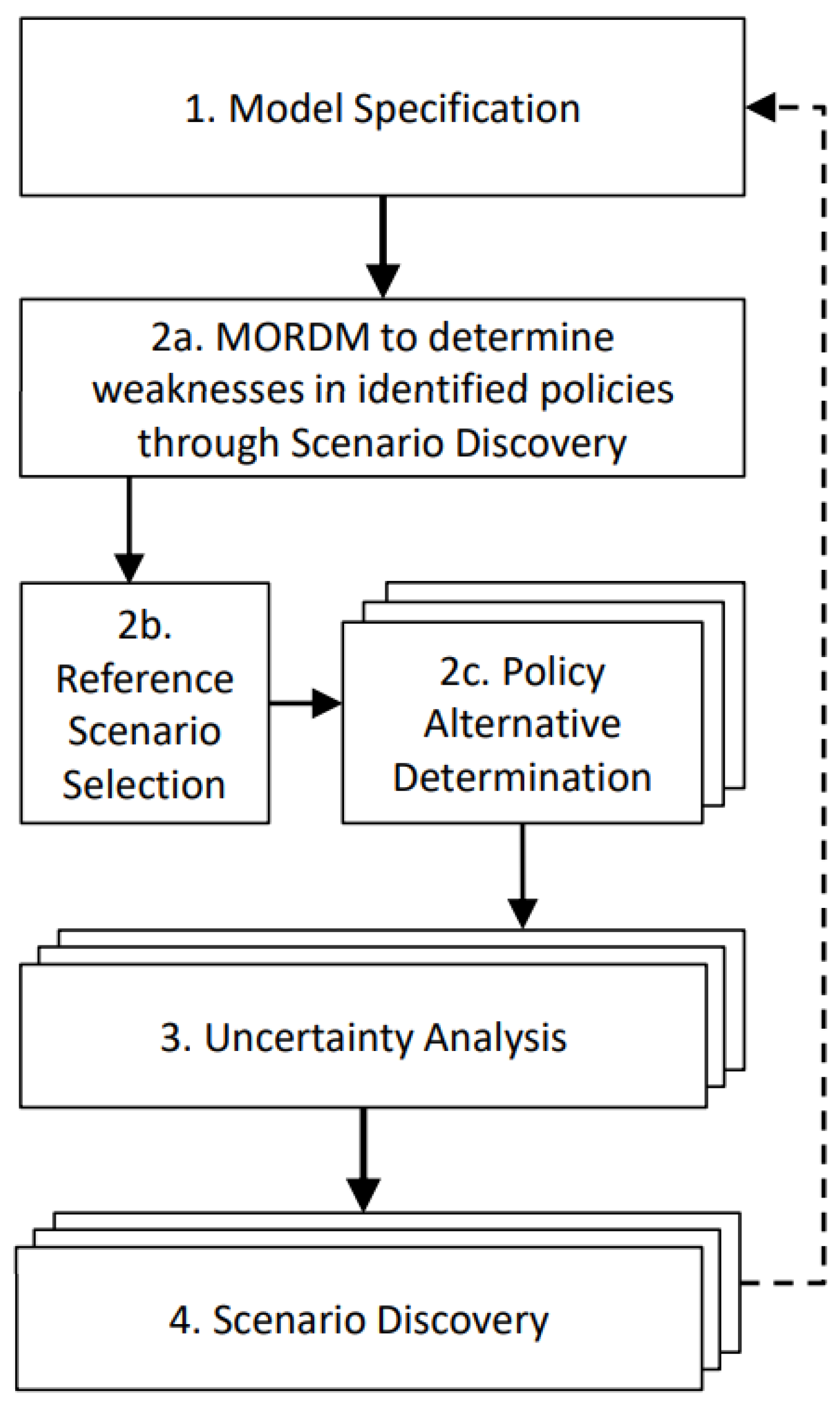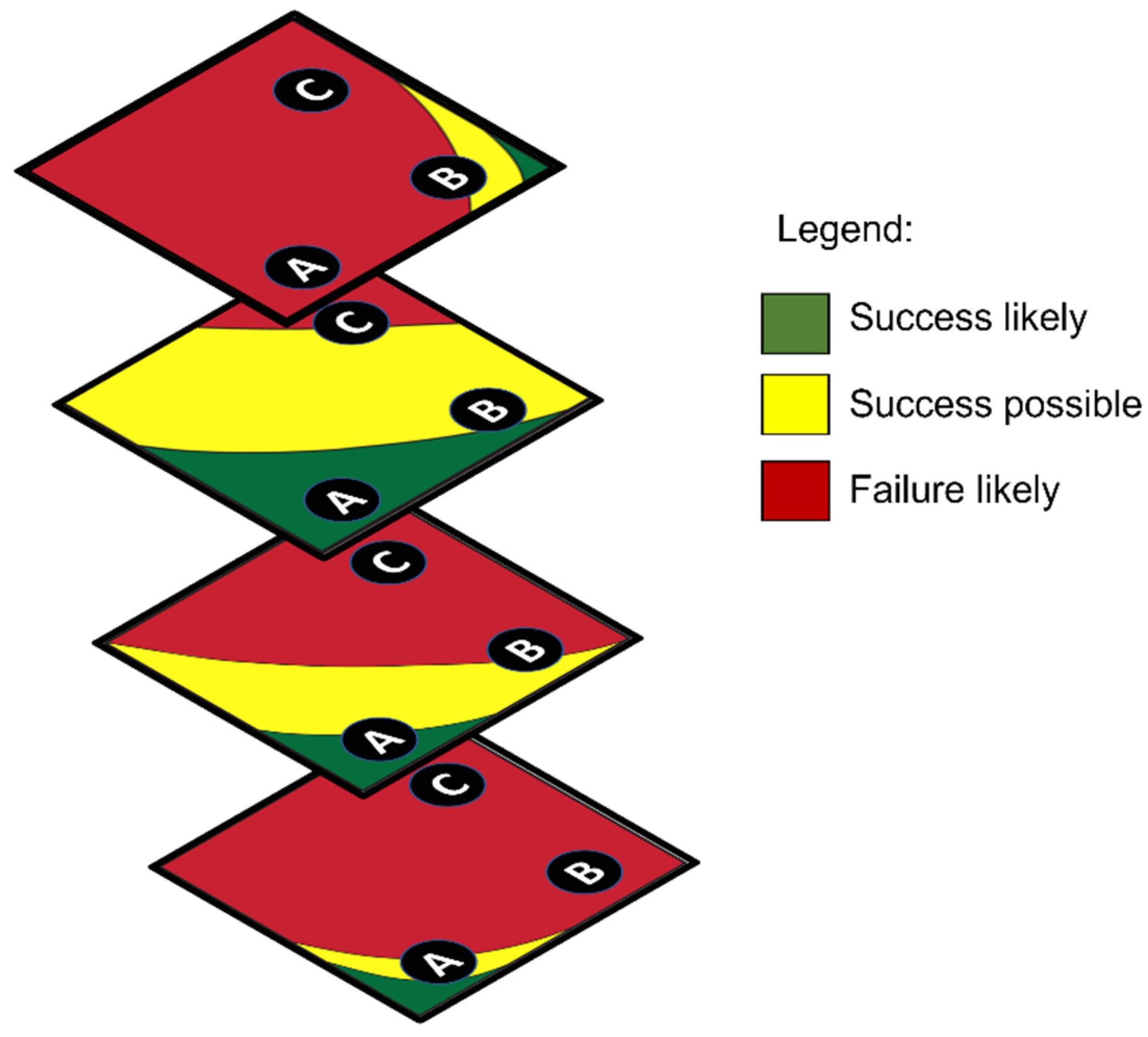Simulation-Based Optimization: Implications of Complex Adaptive Systems and Deep Uncertainty
Abstract
1. Introduction
- The recognition of the inherent complexity of nature and society and the inability of reductionism to cope with these challenges;
- Exploring problems and questions that are not confined to a single discipline;
- Growing societal problems that require a broader approach on a shorter time scale; and
- The emergence of new technologies applicable in more than one discipline.
2. The Problem Domain: New Insights on Optimality
2.1. Optimal Solutions in Complex Adaptive Systems
2.2. Effects of Deep Uncertainty on Optimal Solutions
3. Implications for Simulation-Based Optimization: Extending the Methods
3.1. Addressing Optimal Solutions in Complex Adaptive Systems
3.1.1. Applicable Engineering Methods
- What is the probabilistic distribution within the current point or region?
- What is the sensitivity, including the probabilistic distribution of the neighbored points and region?
- How do these characteristics change over time, particularly in regard to the time span in which and for which a decision needs to be made?
3.1.2. Principles of Graphical Representation
- Allow users to apply their mental models to their situational observations and provide input parameter values. Do not require users to set input parameter values for information that can be accurately and automatically obtained elsewhere.
- Let the user apply their real-world knowledge to set weights or values for the scoring function (the criteria for ranking the options).
- Provide an overview of the several top options and allow users to employ their pattern recognition, judgment, and values to choose the desired option.
- (a)
- Do not have the visualization identify a single, firm recommendation to users.
- (b)
- Do not provide a particularly wide range of options, especially when many of them are much less desirable and thus unlikely to warrant serious consideration.
- When constructing DSVs, tradeoff unnecessary fidelity in favor of speed of response. Determine the required fidelity level based on whether DSVs generated from models of a lower fidelity level would lead to the same decision as DSVs constructed from data obtained via a higher-fidelity model.
- Show the consequences of choosing one option versus another under a variety of possible conditions rather than a single set of “most likely” conditions.
- (a)
- Use a frequency-based presentation, not a probability-based presentation.
- (b)
- Reveal the shapes of the distribution of outcomes.
- Provide interactive filtering and sorting for viewing subsets of the data that underlie the decision space.
- Support comprehension of the factors and relationships mediating the consequences of choosing one option versus another.
3.2. Addressing Optimal Solutions under Deep Uncertainty
- A clear enough future allowing for a single forecast;
- Alternate futures with a few discrete outcomes allowing for traditional decision analysis and game theory;
- A range of futures with a range of possible outcomes, not connected by common scenarios; and
- True ambiguity with no basis to forecast the future.
4. Conclusions and Discussion
Funding
Data Availability Statement
Acknowledgments
Conflicts of Interest
Disclaimer
References
- Ören, T.; Zeigler, B.P.; Tolk, A. Body of Knowledge for Modeling and Simulation—A Handbook by the Society for Modeling and Simulation; Springer Nature: Cham, Switzerland, 2022. [Google Scholar]
- Buckley, W.; Schwendt, D.; Goldstein, J.A. Society as a complex adaptive system. Emerg. Complex. Organ. 2008, 10, 86–113. [Google Scholar]
- Levin, S.A. Ecosystems and the biosphere as complex adaptive systems. Ecosystems 1998, 1, 431–436. [Google Scholar] [CrossRef]
- Choi, T.Y.; Dooley, K.J.; Rungtusanatham, M. Supply networks and complex adaptive systems: Control versus emergence. J. Oper. Manag. 2001, 19, 351–366. [Google Scholar] [CrossRef]
- Ellis, N.C.; Larsen-Freeman, D. Language as a Complex Adaptive System; Wiley-Blackwell: West Sussex, UK, 2009. [Google Scholar]
- Rouse, W.B. Health care as a complex adaptive system: Implications for design and management. Bridge-Wash.-Natl. Acad. Eng. 2008, 38, 17. [Google Scholar]
- Ingwersen, W.W.; Garmestani, A.S.; Gonzalez, M.A.; Templeton, J.J. A systems perspective on responses to climate change. Clean Technol. Environ. Policy 2014, 16, 719–730. [Google Scholar] [CrossRef]
- National Academy of Sciences. Facilitating Interdisciplinary Research; National Academies Press: Washington, DC, USA, 2004. [Google Scholar]
- Gilbert, N.; Ahrweiler, P.; Barbrook-Johnson, P.; Narasimhan, K.P.; Wilkinson, H. Computational modelling of public policy: Reflections on practice. J. Artif. Soc. Soc. Simul. 2018, 21, a3669. [Google Scholar] [CrossRef]
- Henrichs, E.; Lesch, V.; Straesser, M.; Kounev, S.; Krupitzer, C. A literature review on optimization techniques for adaptation planning in adaptive systems: State of the art and research directions. Inf. Softw. Technol. 2022, 149, 106940. [Google Scholar] [CrossRef]
- de Sousa Junior, W.T.; Montevechi, J.A.B.; Campos, A.T.; de Carvahlo Miranda, R. Discrete simulation-based optimization methods for industrial engineering problems: A systematic literature review. Comput. Ind. Eng. 2019, 128, 526–540. [Google Scholar] [CrossRef]
- Hu, X.; Wu, P. A Data Assimilation Framework for Discrete Event Simulations. ACM Trans. Model. Comput. Simul. 2019, 29, 1–26. [Google Scholar] [CrossRef]
- Zabinsiky, Z.B. Stochastic Adaptive Search Methods: Theory and Implementation. In Handbook of Simulation Optimization; Springer: New York, NY, USA, 2015; pp. 293–318. [Google Scholar]
- Page, S.E. Understanding Complexity; Teaching Company: Chantilly, VA, USA, 2009. [Google Scholar]
- Jameson, A. Gradient Based Optimization Methods; MAE Technical Report No. 2057; Stanford: Stanford, CA, USA, 1995. [Google Scholar]
- Bengio, Y. Gradient-based optimization of hyperparameters. Neural Comput. 2000, 12, 1889–1900. [Google Scholar] [CrossRef]
- Suman, B.; Kumar, P. A survey of simulated annealing as a tool for single and multiobjective optimization. J. Oper. Res. Soc. 2006, 57, 1143–1160. [Google Scholar] [CrossRef]
- Lambora, A.; Gupta, K.; Chopra, K. Genetic algorithm—A literature review. In Proceedings of the IEEE International Conference on Machine Learning, Big Data, Cloud and Parallel Computing, Faridabad, India, 14–16 February 2019; pp. 380–384. [Google Scholar]
- Amaran, S.; Sahinidis, N.V.; Sharda, B.; Bury, S.J. Simulation optimization: A review of algorithms and applications. Ann. Oper. Res. 2016, 240, 351–380. [Google Scholar] [CrossRef]
- Greasley, A. Simulation Modelling for Business; Routledge: London, UK, 2017. [Google Scholar]
- Tolk, A. Engineering Principles of Combat Modeling and Distributed Simulation; John WIley & Sons: Hoboken, NJ, USA, 2012. [Google Scholar]
- Marchau, V.A.W.J.; Walker, W.E.; Bloemen, P.J.T.M.; Popper, S.W. Decision Making under Deep Uncertainty: From Theory to Practice; Springer Nature: Cham, Switzerland, 2019. [Google Scholar]
- Hüllermeier, E.; Waegeman, W. Aleatoric and epistemic uncertainty in machine learning: An introduction to concepts and methods. Mach. Learn. 2021, 110, 457–506. [Google Scholar] [CrossRef]
- Kruse, R.; Schwecke, E.; Heinsohn, J. Uncertainty and Vagueness in Knowledge Based Systems: Numerical Methods; Springer: Berlin/Heidelberg, Germany, 1991. [Google Scholar]
- Lempert, R.J.; Popper, S.W.; Bankes, S.C. Shaping the Next One Hundred Years: New Methods for Quantitative Long-Term Policy Analysis; RAND Report MR-1626; The RAND Pardee Center: Santa Monica, CA, USA, 2003. [Google Scholar]
- Kandlikar, M.; Risbey, J.; Dessai, S. Representing and communicating deep uncertainty in climate-change assessments. C. R. Geosci. 2005, 337, 443–455. [Google Scholar] [CrossRef]
- Marchau, V.A.W.J.; Walker, W.E.; van Wee, G.P. Dynamic adaptive transport policies for handling deep uncertainty. Technol. Forecast. Soc. Chang. 2010, 77, 940–950. [Google Scholar] [CrossRef]
- Paul, S.; Venkateswaran, J. Designing robust policies under deep uncertainty for mitigating epidemics. Comput. Ind. Eng. 2020, 140, 106221. [Google Scholar] [CrossRef]
- Molina-Perez, E. Directed International Technological Change and Climate Policy: New Methods for Identifying Robust Policies under Conditions of Deep Uncertainty; The Pardee RAND Graduate School: Santa Monica, CA, USA, 2016. [Google Scholar]
- Brock, W.; Xepapadeas, A. Regional climate policy under deep uncertainty: Robust control and distributional concern. Environ. Dev. Econ. 2021, 26, 211–238. [Google Scholar] [CrossRef]
- Law, A.M.; McComas, M.G. Simulation-based optimization. In Proceedings of the Winter Simulation Conference, San Diego, CA, USA, 8–11 December 2002; pp. 41–44. [Google Scholar]
- Carson, Y.; Maria, A. Simulation Optimization: Methods and Applications. In Proceedings of the Winter Simulation Conference, Atlanta, GA, USA, 7–10 December 1997; pp. 118–126. [Google Scholar]
- Afifi, A.; May, S.; Clark, V.A. Practical Multivariate Analysis, 5th ed.; Chapman and Hall/CRC: Boca Raton, FL, USA, 2011. [Google Scholar]
- Davis, P.K. Paradigm-Level Issues in M&S: Historical Lessons and Current Challenges. In Proceedings of the Interservice/Industry Training, Simulation, and Education Conference, Orlando, FL, USA, 29 November–2 December 2010. [Google Scholar]
- Sheard, S.; Cook, S.; Honour, E.; Hybertson, D.; Krupa, J.; McEver, J.; McKinney, D.; Ondrus, P.; Ryan, A.; Scheurer, R.; et al. A Complexity Primer for Systems Engineers; INCOSE: San Diego, CA, USA, 2015. [Google Scholar]
- Shalizi, C.R. Methods and techniques of complex systems science: An overview. In Complex Systems Science in Biomedicine; Springer: Berlin/Heidelberg, Germany, 2006; pp. 33–114. [Google Scholar]
- Marler, R.T.; Arora, J.S. Survey of multi-objective optimization methods for engineering. Struct. Multidiscip. Optim. 2004, 26, 369–395. [Google Scholar] [CrossRef]
- Davis, P.K. A new ethical principle for analysts who use models. In Proceedings of the Winter Simulation Conference, Phoenix, AZ, USA, 13–15 December 2021. [Google Scholar]
- Davis, P.K. Lessons from RAND’s Work on Planning under Uncertainty for National Security; RAND: Santa Monica, CA, USA, 2012. [Google Scholar]
- Drury, J.L.; Pfaff, M.S.; Klein, G.L.; Liu, Y. Decision space visualization: Lessons learned and design principles. In Proceedings of the International Conference on Human-Computer Interaction, Las Vegas, NV, USA, 21–26 July 2013; Springer: Berlin/Heidelberg, Germany, 2013; pp. 658–667. [Google Scholar]
- Nielsen, J. Heuristic evaluation. In Usability Inspection Methods; John WIley & Sons: Hoboken, NJ, USA, 1994; pp. 25–62. [Google Scholar]
- Norman, D.A. The Design of Everyday Things; Basic Books: New York, NY, USA, 1988. [Google Scholar]
- Shneiderman, B.C.P.; Cohen, M.S.; Jacobs, S.; Elmqvist, N.; Diakopoulos, N. Designing the User Interface: Strategies for Effective Human Computer Interaction, 6th ed.; Pearson: New York, NY, USA, 2016. [Google Scholar]
- Pfaff, M.S.; Klein, G.L.; Drury, J.L.; Moon, S.P.; Liu, Y.; Entezari, S.O. Supporting complex decision making through option awareness. J. Cogn. Eng. Decis. Mak. 2013, 7, 155–178. [Google Scholar] [CrossRef]
- Courtney, H.; Kirkland, J.; Viguerie, P. Strategy under uncertainty. Harv. Bus. Rev. 1997, 75, 67–79. [Google Scholar]
- Heidelberger, P. Fast simulation of rare events in queueing and reliability models. In Performance Evaluation of Computer and Communication Systems; Springer: Berlin/Heidelberg, Germany, 1993; pp. 165–202. [Google Scholar]
- Taleb, N.N. The Black Swan: The Impact of the Highly Improbable; Random House: New York, NY, USA, 2007. [Google Scholar]
- Kwakkel, J.H.; Pruyt, E. Exploratory Modeling and Analysis, an approach for model-based foresight under deep uncertainty. Technol. Forecast. Soc. Chang. 2013, 80, 419–431. [Google Scholar] [CrossRef]
- Kasprzyk, J.R.; Nataraj, S.; Reed, P.M.; Lempert, R.J. Many objective robust decision making for complex environmental systems undergoing change. Environ. Model. Softw. 2013, 42, 55–71. [Google Scholar] [CrossRef]
- Watson, A.A.; Kasprzyk, J.R. Incorporating deeply uncertain factors into the many objective search process. Environ. Model. Softw. 2017, 89, 159–171. [Google Scholar] [CrossRef]
- Wardley, S. The future is more predictable than you think—A workbook for value chain mapping. In Leading Edge Forum; CRC Press: Baco Raton, FL, USA, 2013. [Google Scholar]
- Chen, H.; Zhang, S.; Chen, W.; Mei, H.; Zhang, J.; Mercer, A.; Liang, R.; Qu, H. Uncertainty-Aware Multidimensional Ensemble Data Visualization and Exploration. IEEE Trans. Vis. Comput. Graph. 2015, 21, 1072–1086. [Google Scholar] [CrossRef] [PubMed]
- Shavazipour, B.; López-Ibáñez, M.; Miettinen, K. Visualizations for decision support in scenario-based multiobjective optimization. Inf. Sci. 2021, 578, 1–21. [Google Scholar] [CrossRef]
- Forni, L.G.; Galaitsi, S.E.; Mehta, V.K.; Escobar, M.I.; Purkey, D.R.; Depsky, N.J.; Lima, N.A. Exploring scientific information for policy making under deep uncertainty. Environ. Model. Softw. 2016, 86, 232–247. [Google Scholar] [CrossRef]
- Kwakkel, J.H. The Exploratory Modeling Workbench: An open source toolkit for exploratory modeling, scenario discovery, and (multi-objective) robust decision making. Environ. Model. Softw. 2017, 96, 239–250. [Google Scholar] [CrossRef]
- Nuzzo, R. Statistical errors. Nature 2014, 506, 150–152. [Google Scholar] [CrossRef]
- Davis, P.K.; Popper, S.W. Confronting Model Uncertainty in Policy Analysis for Complex Systems: What Policymakers Should Demand. J. Policy Complex Syst. 2019, 5, 181–201. [Google Scholar] [CrossRef]
- Harper, A.; Mustafee, N.; Yearworth, M. Facets of trust in simulation studies. Eur. J. Oper. Res. 2021, 289, 197–213. [Google Scholar] [CrossRef]
- Tolk, A.; Lane, J.E.; Shults, F.L.; Wildman, W.J. Panel on ethical constraints on validation, verification, and application of simulation. In Proceedings of the Winter Simulation Conference, Phoenix, AZ, USA, 13–15 December 2021. [Google Scholar]
- Rouse, W.B. Understanding the complexity of health. Syst. Res. Behav. Sci. 2021, 2, 38. [Google Scholar] [CrossRef]
- Haberlin, R.J.; Page, E.H. Visualization Support to Strategic Decision-Making. In Simulation and Wargaming; Jogn Wiley & Sons: Hoboken, NJ, USA, 2022; pp. 317–334. [Google Scholar]
- Walker, W.E.; Marchau, V.A.; Kwakkel, J.H. Dynamic Adaptive Planning (DAP). In Decision Making under Deep Uncertainty; Springer Nature: Cham, Switzerland, 2019; pp. 53–69. [Google Scholar]
- Haasnoot, M.; Warren, A.; Kwakkel, J.H. Dynamic adaptive policy pathways (DAPP). In Decision Making under Deep Uncertainty; Springer Nature: Cham, Switzerland, 2019; pp. 71–92. [Google Scholar]
- Fu, M.C. Handbook of Simulation Optimization, International Series in Operations Research & Management Science (Volume 216); Springer: New York, NY, USA, 2015. [Google Scholar]
- Nelson, B.L.; Pei, L. Foundations and Methods of Stochastic Simulation, 2nd ed.; International Series in Operations Research & Management Science (Volume 316); Springer Nature: Cham, Switzerland, 2021. [Google Scholar]
- Mittal, S.; Durak, U.; Ören, T. Guide to Simulation-Based Disciplines: Advancing our Computational Future; Springer Nature: Cham, Switzerland, 2017. [Google Scholar]
- Keating, C.; Rogers, R.; Unal, R.; Dryer, D.; Sousa-Poza, A.; Safford, R.; Peterson, W.; Rabadi, G. System of systems engineering. Eng. Manag. J. 2003, 15, 36–45. [Google Scholar] [CrossRef]
- Farooq, M.U.; Waseem, M.; Mazhar, S.; Khairi, A.; Kamal, T. A Review on Internet of Things (IoT). Int. J. Comput. Appl. 2015, 113, 1–7. [Google Scholar]
- Tolk, A.; Barry, P.; Doskey, S.C. Using modeling and simulation and artificial intelligence to improve complex adaptive systems engineering. Int. J. Model. Simul. Sci. Comput. 2021, 13, 2241004. [Google Scholar] [CrossRef]
- Mittal, S. Emergence in stigmergic and complex adaptive systems: A formal discrete event systems perspective. Cogn. Syst. Res. 2013, 21, 22–39. [Google Scholar] [CrossRef]
- Rainey, L.B.; Holland, O.T. Emergent Behavior in System of Systems Engineering: Real-World Applications; CRC Press: Baco Raton, FL, USA, 2022. [Google Scholar]
- Darley, V. Emergent phenomena and complexity. Artif. Life 1994, 4, 411–416. [Google Scholar]






| Analyze | Diagnose | Model | Synthesize |
|---|---|---|---|
| Data Mining | Algorithmic Complexity | Uncertainty Modeling | Design Structure Matrix |
| Splines | Monte Carlo Methods | Virtual Immersive Modeling | Architectural Frameworks |
| Fuzzy Logic | Thermodynamic Depth | Functional/Behavioral Models | Simulated Annealing |
| Neural Networks | Fractal Dimension | Feedback Control Models | Artificial Immune System |
| Classification and Regression Trees | Information Theory | Dissipative Systems | Particle Swarm Optimization |
| Kernel Machines | Statistical Complexity | Game Theory | Genetic Algorithms |
| Nonlinear Time Series Analysis | Graph Theory | Cellular Automata | Multi-Agent Systems |
| Markov Chains | Functional Information | System Dynamics | Adaptive Networks |
| Power Law Statistics | Multi-scale Complexity | Dynamical Systems | |
| Social Network Analysis | Network Models | ||
| Agent-based Models | |||
| Multi-Scale Models |
| Level 1 | Level 2 | Level 3 | Level 4 | Level 5 | |
|---|---|---|---|---|---|
| Context | A clear enough future (with sensitivity) | Alternate futures (with probabilities) | Alternate futures (with ranking) | A multiplicity of plausible futures (unranked) | Unknown future |
| System Model | A single system model | A single system model with a probabilistic parametrization | Several system models with different structures with assigned likelihoods | Several system models with different structures | Unknown system model, but we know what we do not know |
| System Outcomes | Point estimates with sensitivity | Several sets of point estimates with confidence intervals | Several sets of point estimates ranked according to their perceived likelihood | A known range of outcomes | Unknown outcomes, but we know what we do not know |
| Weights on Outcomes | A single estimate of the weights | Several sets of weights with probabilities assigned | Several sets of weights ranked according to their perceived likelihood | A known range of weights | Unknown weights, but we know what we do not know |
| Simulation Support | Simulation-based optimization | Probabilistic simulation-based optimization | Simulations for each system model as the basis for probabilistic optimization | Simulations for each system model to generate the range of outcomes and weights | Without a system model, simulation-based optimization is not possible |
Publisher’s Note: MDPI stays neutral with regard to jurisdictional claims in published maps and institutional affiliations. |
© 2022 by The MITRE Corporation. Licensee MDPI, Basel, Switzerland. This article is an open access article distributed under the terms and conditions of the Creative Commons Attribution (CC BY) license (https://creativecommons.org/licenses/by/4.0/).
Share and Cite
Tolk, A. Simulation-Based Optimization: Implications of Complex Adaptive Systems and Deep Uncertainty. Information 2022, 13, 469. https://doi.org/10.3390/info13100469
Tolk A. Simulation-Based Optimization: Implications of Complex Adaptive Systems and Deep Uncertainty. Information. 2022; 13(10):469. https://doi.org/10.3390/info13100469
Chicago/Turabian StyleTolk, Andreas. 2022. "Simulation-Based Optimization: Implications of Complex Adaptive Systems and Deep Uncertainty" Information 13, no. 10: 469. https://doi.org/10.3390/info13100469
APA StyleTolk, A. (2022). Simulation-Based Optimization: Implications of Complex Adaptive Systems and Deep Uncertainty. Information, 13(10), 469. https://doi.org/10.3390/info13100469






